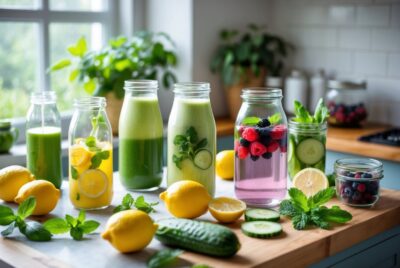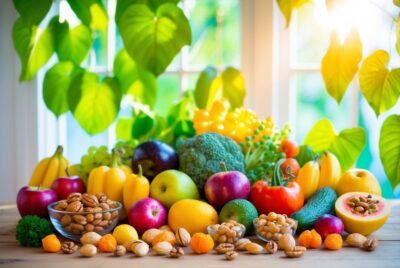Raw Food Diet: A Journey to Natural Health
*We may earn a commission for purchases made using our links. Please see our disclosure to learn more.
Raw Food Diet Benefits: Unveiling Nutritional Advantages
A raw food diet primarily focuses on consuming unprocessed, plant-based foods that have not been heated above a certain temperature. As someone who advocates for health and well-being, I find that this diet encourages the intake of whole, living foods filled with enzymes, vitamins, and minerals. It’s common for individuals to adopt a raw food diet for its potential health benefits, including weight loss and improved vitality. My experience has shown that a raw food diet could serve as an effective means to not only shed pounds but also to invigorate the body’s natural healing processes.

While some variations of the diet might include raw animal products, I often advise a vegan approach, which excludes all animal products, ensuring a compassionate, cruelty-free lifestyle. This vegan path aligns with a considerable environmental benefit, as the footprint of a plant-based diet is significantly smaller. However, I stress the importance of careful planning. To maintain a well-rounded nutritional profile, one must ensure adequate intake of all essential nutrients to prevent deficiencies.
When I discuss the raw food lifestyle, I underscore that it’s not merely about weight management. It’s a holistic approach to living that requires a thoughtful balance of food choices to support overall health and well-being. People interested in this diet should carefully consider their dietary needs, preferences, and lifestyle before making the transition to ensure it’s a sustainable and beneficial change for them.
Fundamentals of Raw Food Diet

In discussing the raw food diet, I’ll explore how it’s defined, its core principles, and the variations within the diet.
Defining Raw Food Diet
A raw food diet is a regime that emphasizes the consumption of uncooked and unprocessed foods. Typically, a food is considered raw if it has not been heated above temperatures of 104-118°F (40-48°C). I observe that a raw food diet features a variety of whole foods such as fresh fruits, vegetables, nuts, seeds, and sprouted grains.
Key Principles
The primary essence of a raw food diet rests on the consumption of foods in their natural state, which I perceive as untainted by cooking or extensive processing. This practice stems from the belief that cooking can diminish the nutritional value of foods. Whole foods play a central role in this diet, and they are preferred for their nutrient density and natural state. Here’s a concise list of key principles I recognize:
- Maximization of Nutrients: Prioritize foods that retain their enzymatic structure and rich nutrient profile.
- Minimization of Processing: Avoid foods that have been pasteurized, refined, or treated with pesticides.
- Variety and Balance: Include a wide range of fruits and vegetables to ensure a comprehensive intake of vitamins and minerals.
Types of Raw Food Diets
There are several types of raw food diets that I’ve come across, each with its own specifics:
- Raw Vegan Diet: Excludes all animal products; focuses exclusively on plant-based foods.
- Raw Vegetarian Diet: May include raw eggs and dairy, while still emphasizing plant-based foods.
- Raw Omnivorous Diet: Incorporates raw animal products such as sashimi, raw dairy, or carpaccio.
Each type of diet underscores the fundamental importance of uncooked and unprocessed foods, yet they vary in their inclusion of animal-based items.
Health and Nutritional Aspects
When examining the health and nutritional aspects of the raw food diet, I will focus on its benefits, potential nutrient deficiencies, and effects on digestive health.

Benefits and Advantages
A raw food diet is rich in nutrients such as vitamins and minerals that are essential for my body. Vitamins and antioxidants present in raw fruits and vegetables act as a protective shield against diseases by combating free radicals. I find that enzymes, which facilitate countless biochemical reactions in my body, are preserved in their natural state in raw foods. Studies suggest that raw food consumers may have lower body fat, which could be attributed to a diet high in fiber and healthy fats, yet low in calories and processed foods.
- Antioxidants: Protect cells from damage
- Fiber: Aids in digestion and satiety
- Vitamins: Supports overall health
- Enzymes: Promote efficient metabolic processes.
The raw diet is also abundant in phytochemicals, like lycopene, which are known for their potential cancer-fighting properties. The high fiber content can lead to increased feelings of fullness, contributing to weight management. By including a variety of raw plant-based foods, I ensure to get a comprehensive range of minerals and nutrients.
Potential Nutrient Deficiencies
While the raw food diet offers numerous benefits, it can also lead to potential nutrient deficiencies if not carefully planned. Critical nutrients that could be insufficient include protein, iron, calcium, vitamin B12, and vitamin D. These nutrients are typically found in greater concentrations in animal products, which may not be consumed in high quantities, or at all, by individuals on a raw food diet.
- Protein: Essential for muscle repair and growth
- Iron: Vital for oxygen transport in blood
- Calcium: Necessary for bone health
- Vitamin B12: Important for nerve function and blood cell formation
- Vitamin D: Crucial for immune function and bone health.
I take extra care to include sources of these nutrients, such as green leafy vegetables for calcium and fortified foods or supplements for vitamin B12 and vitamin D. Understanding and managing phytic acid, which can be found in raw seeds and grains and can impede the absorption of certain minerals, is also important.
Digestive Health
Consuming raw foods means that natural enzymes are intact, which I find aids in the breakdown and digestion of food. The high intake of fiber from raw fruits and vegetables can improve digestive health by maintaining bowel regularity and preventing constipation.
- Natural enzymes: Help with food digestion
- Fiber: Promotes gut health and regular bowel movements.
However, individuals with sensitive digestive systems or conditions such as irritable bowel syndrome (IBS) may experience discomfort due to the high fiber content. In these cases, a gradual increase in raw food intake is advisable to allow my digestive system to adjust.
Food Preparation Techniques

In a raw food diet, I focus on retaining the natural nutrients and enzymes in my food. Thus, my preparation methods are paramount in maximizing the benefits of raw ingredients.
Methods to Process Raw Foods
Blending: I use a high-powered blender to puree fruits and vegetables, creating smoothies that are nutrient-rich and easily digestible. This technique preserves the food’s natural enzymes.
Juicing: To extract juices, I use a juicer, which separates the pulp from the liquid. This results in a concentrated nutrient intake, beneficial for quick absorption of vitamins and minerals.
Soaking: I often soak nuts and seeds to deactivate their natural inhibitors, making them easier to digest and their nutrients more available.
Sprouting: By sprouting seeds, grains, and legumes, I enhance their nutritional profile as it increases vitamin content and makes them easier to digest.
Dehydrating: I use a dehydrator to remove moisture from food at low temperatures, thus preserving the enzymes. This is ideal for making dried fruits, vegetables, and crackers that maintain a raw status.
Hydrating: To rejuvenate dehydrated food, adequate hydration is critical. I ensure my consumption of these foods includes proper rehydration for ease of digestion.
Equipment Essentials
For all my raw food preparation, there are a few key pieces of equipment I find indispensable:
Blender: An essential for smooth blending of fruits and vegetables for various recipes like smoothies and soups.
Dehydrator: A must-have to create a range of textures while still keeping foods raw; it can be used for making fruit leathers, raw breads, and much more.
Juicer: I use this to make fresh juice, which can be a big part of my raw food diet, providing concentrated nutrients.
Sprouting containers: These are necessary for sprouting seeds and legumes, allowing for increased bioavailability of nutrients.
Careful use of these tools helps me adhere to a raw food diet while still enjoying a diverse and nutritious range of foods.
Safety and Risks

When adopting a raw food diet, I prioritize understanding the potential safety concerns and risks associated with consuming uncooked and unprocessed foods. My focus is ensuring that food contamination is avoided and proper handling and storage techniques are employed to minimize the risk of food-borne illnesses.
Avoiding Food Contamination
To prevent the introduction of harmful bacteria and potential food poisoning, I am careful about the selection of raw foods. Foods like raw meat, raw eggs, raw fish, and raw dairy can harbor bacteria such as Salmonella and E. coli. These bacteria can lead to serious health issues. Therefore, I opt for high-quality, fresh produce and I am wary of consuming raw animal products, which are typically safer to eat when cooked thoroughly.
- Raw Animal Products: Avoid or limit consumption. If consumed, ensure they come from reputable sources with high safety standards.
- Raw Vegetables and Fruits: Wash thoroughly under running water to remove soil and microbes.
Handling and Storage
Proper handling and storage are crucial in my approach to a raw food diet. By storing foods at the correct temperature, I minimize the proliferation of bacteria. I keep my refrigerator below 40°F (4°C) and my freezer at 0°F (-18°C) to maintain the safety of raw foods.
- Refrigeration: Essential for raw foods, especially perishables like fruits, vegetables, and certain raw dairy products.
- Separation: I store raw animal products away from other foods to avoid cross-contamination.
By following these guidelines, I aim to reduce the risks of chronic diseases and ensure that my raw food diet is as safe and beneficial as possible.
Lifestyle Considerations

In considering a raw food diet, I focus primarily on how it integrates into my daily life and its broader impacts. My goals include meeting nutritional needs while considering financial and ecological footprints.
Daily Meal Planning
When planning my daily meals, I ensure that they are predominantly plant-based and uncooked to align with the raw food diet’s principles. I typically consume a variety of vegetables, fruits, nuts, seeds, and sprouted grains to maintain energy throughout the day. For protein, I might include raw dairy or eggs, though some raw food adherents choose a completely vegan approach. I consult registered dietitians to create balanced meal plans that meet my dietary requirements without cooking, as raw foodism emphasizes consuming food in its most natural state.
- Breakfast: A smoothie with spinach, bananas, berries, and almond milk.
- Lunch: A salad made of mixed greens, cherry tomatoes, avocados, and sprouted legumes.
- Dinner: Sushi rolls with raw vegetables and cauliflower rice.
Economic and Environmental Impact
Adopting a raw food diet can be expensive, as organic and fresh produce usually costs more. I’m aware that seasonal purchasing and local sourcing can mitigate some expenses. The diet’s environmental impact is nuanced; on one hand, it reduces energy consumption since I don’t cook food. On the other hand, if I heavily rely on imported or non-local produce, the transportation might negate those energy savings. It is a balance I continuously strive to achieve.
Frequently Asked Questions
In this section, I’ll address some of the most common inquiries about the raw food diet, providing factual clarity to help you understand this dietary practice.
1. What types of foods can you eat on a raw food diet?
On a raw food diet, I can consume a variety of uncooked and unprocessed foods. My diet typically includes fresh fruits, vegetables, nuts, seeds, and sprouted grains. Some raw foodists also incorporate raw eggs, dairy, and meat, though this depends on individual dietary choices.
2. How can a raw food diet potentially benefit your health?
The raw food diet may offer health benefits due to its emphasis on whole, unprocessed foods that are high in nutrients and enzymes. It can lead to improved digestion, higher energy levels, and due to its anti-inflammatory properties, may potentially aid in reducing the symptoms of certain chronic conditions.
3. What are the potential risks associated with a raw food diet?
Adopting a raw food diet holds potential risks such as nutritional deficiencies, particularly in vitamin B12, iron, and omega-3 fatty acids. The risk of foodborne illness increases from consuming uncooked products, and if I don’t plan my meals carefully, I might not consume enough calories or nutrients.
4. Can you provide a sample meal plan for a week on a raw food diet?
My sample weekly meal plan on a raw food diet would include a variety of smoothies, salads, and nuts for breakfasts, lunches, and dinners. Each day would feature a different combination of fruits, vegetables, and seeds, ensuring diverse nutrient intake without any cooking process involved.
5. How does a raw food diet impact weight loss and maintenance?
Due to its nature, a raw food diet is often lower in calories and higher in fiber, which may lead to weight loss. As for maintaining a healthy weight, it’s essential to ensure I’m getting a balanced intake of calories alongside sufficient protein and healthy fats to meet my body’s needs.




